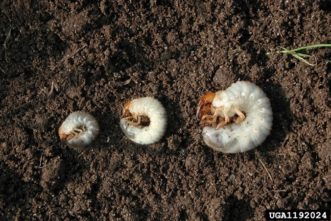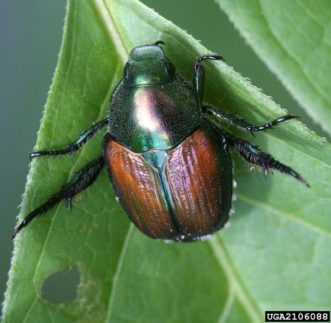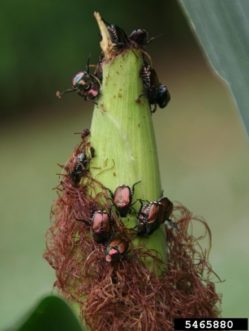Japanese beetle, Popillia japonica, is a generalist pest capable of feeding on over 300 different plant species, many of which are of economic importance.1 One of the main crops that Japanese beetle can be a pest of is field corn, Zea mays, one of the most important cereal crops in the United States. The purpose of this article is to provide background information on the Japanese beetle, describe the injury to corn, and discuss management strategies.
Identification and Life Cycle
Japanese beetles are native to northern Japan and were first identified in the United States in northern New Jersey in 1916.1 Since its introduction, it has spread across the United States and is currently considered to be established in twenty-eight states, including South Carolina, with partial establishment in six other states.2

Figure 1. White grubs of various common scarab beetle species, from left to right; Japanese beetle (Popillia japonica), European chafer (Amphimallon majalis), and June bug (Phyllophaga sp.). Image credit: David Cappaert, Bugwood.org.
Japanese beetles are a species of scarab beetle belonging to the family Scarabaeidae. Japanese beetles have an annual life cycle, meaning they produce a single generation per year. Eggs are laid singly in the soil and vary in shape; however, they are generally spherical and creamy white in color. Each female beetle can lay up to sixty eggs in a given year, and eggs hatch in ten to fourteen days.3 Eggs are around one and a half millimeters in diameter and will generally not be found through sampling efforts.3 Larvae then develop through three stages, the third of which overwinters in the soil. Japanese beetle larvae are “C”-shaped white grubs with a yellowish-brown head capsule (figure 1). Larvae have brown hairs on the tip of the abdomen, which, if viewed under a microscope, can be used to differentiate larvae of Japanese beetles from many other similar scarab beetle larvae. For the purposes of managing Japanese beetle in corn, identifying white grub larvae to species is not important. Japanese beetle larvae are one of the smallest of the common scarab beetle species (note the comparison to two other species in figure 1). Larvae have very limited mobility in the soil and will feed on plant roots or vegetation in the immediate area of oviposition (i.e., egg laying).4 For this reason, the oviposition site selection is very important, with preference for areas with low grassy weeds, high soil moisture, high sunlight, and reduced tillage practices.5–8 Oviposition can also occur in crop fields; however, soybean is a preferred host over corn.9

Figure 2. Japanese beetle adult. Note the tufts of white hair on the abdomen, which can aid in differentiation between this and other similar scarab beetle species. Image credit: David Cappaert, Bugwood.org.
Pupae have visible legs, are about fourteen millimeters long and seven millimeters wide, and range in color from pale cream to metallic green. Adult beetles emerge from the soil in early summer (early- to mid-June in South Carolina) with around twenty mature eggs which are oviposited prior to mating and initiating feeding. Adult beetles are bright metallic green and have coppery-bronze-colored wing coverings (elytra) (figure 2). Along each side of the body, there are five spots of white hairs and two of these spots on the top of the last abdominal segment. These hairs can help to distinguish the adult Japanese beetle from similar species.3 Some similar species that co-occur with Japanese beetle include the false Japanese beetle, masked chafer, may beetle, shiny leaf chafer, and June beetle.
Damage to Corn

Figure 3. Corn ear with silks clipped by Japanese beetles. Image credit: Darren Mueller, Iowa State University, Bugwood.org.
Japanese beetles are highly polyphagous, meaning they can feed on a broad range of plants. In field corn, they are considered a sporadic pest; however, they can cause significant injury under the right conditions. The primary mechanism of injury in corn is adult beetles feeding on the silks preventing proper pollination (figure 3).10 Silk clipping can reduce the number of kernels per ear and the total kernel weight, subsequently reducing the overall yield.11 The effect of silk clipping can be exaggerated by drought stress, as silking and pollination is a critical period for successful kernel development.12
Larvae of Japanese beetles can also feed directly on corn roots along with a complex of other soil pests, including rootworms, wireworms, and seed corn maggots, although this type of injury seems to be rare and is hard to quantify.
Management
Cultural Control
Increased numbers of Japanese beetles are often found in fields with reduced tillage systems or fields which have followed sod, cover crops, or soybeans. In addition to in-field conditions, the surrounding landscape can impact the number of Japanese beetles in a field. Fields surrounded by suitable crop hosts, weedy hosts, or uncultivated land can have higher infestation levels.3,13 For example, nearby soybean fields can serve as a source of adult beetles.10 Smartweed and evening primrose are two common weed hosts that can also serve as a source of infestation.7,8 While exact flight potential has not been documented, adult beetles are reported to be highly mobile, meaning they can disperse readily between suitable hosts. Rotating corn with less suitable crop hosts such as cotton or sorghum and limiting suitable oviposition habitat surrounding a cornfield can potentially reduce the risk of Japanese beetle infestation.9,10 While field site selection can potentially reduce Japanese beetle numbers, these patterns are difficult to predict and will not prevent all risk of Japanese beetle infestation. Until more accurate predictions can be made on the effects of landscape features on the risk of damage to corn, management decisions will need to rely on insecticides as the primary control tactic.
Chemical Control
Insecticide applications for larvae are generally not recommended unless managed as part of a complex of soil pests in a field with a history of soil pest issues. Managing larvae in surrounding areas is also not recommended as adult beetles are highly mobile. It is difficult to predict infestation patterns well enough to manage adults through insecticide applications targeted at larval stages.
Silk clipping will cause the most yield loss if it occurs during the first five days of silking, so scouting and management decisions should occur quickly once silking begins. If adult Japanese beetle damage is suspected, the current recommendation is to examine five random plants in five locations in the field for silk clipping.10 An insecticide application may be justified if scouting reveals that at each scouting location there are three or more beetles per ear (fifteen or more beetles per five ears), silks clipped to ½ inch or less on each of the five ears, and when pollination is less then 50% complete for the field.10,11 There can be a significant edge effect in Japanese beetle populations14, illustrating the importance of scouting in multiple locations throughout the field. If the infestation is concentrated on the edge of a field, an insecticide application in that location alone may be sufficient.
Generally speaking, a single application of a pyrethroid insecticide is effective for Japanese beetle management, and many pyrethroids are labeled for corn.15 Speak to your county Cooperative Extension Agent or search for specific insecticide information and recommendations on the websites of your state’s universities that provide agronomic crops information.
Summary
Japanese beetle is a sporadic pest of field corn that can be damaging under the right conditions. Selecting a site that minimizes the risk of infestation and conducting properly timed scouting can allow growers to make informed management decisions that greatly reduce or eliminate the risk of Japanese beetles causing yield loss in corn.
References Cited
- Dickerson E, Weiss H. Popillia japonica Newm., a recently introduced Japanese pest. The Canadian Entomologist. 1918;50(7):217–221.
- Japanese Beetle Distribution in the U.S. Riverdale Park (MD): USDA Animal and Plant Health Inspection Service (APHIS); 2018. https://www.aphis.usda.gov/plant_health/plant_pest_info/jb/downloads/jb-distribution-map.pdf.
- Fleming WE. Biology of the Japanese beetle. Washington (DC): USDA ARS Technical Bulletin No. 1449; 1972.
- Potter DA, Held DW. Biology and management of the Japanese beetle. Annual Review of Entomology. 2002;47:175–205.
- Hammond RB, Stinner BR. Soybean foliage insects in conservation tillage systems: effects of tillage, previous cropping history, and soil insecticide application. Environmental Entomology. 1987;16(2):524–531.
- Smitley DR. Incidence of Popillia japonica (Coleoptera: Scarabaeidae) and other scarab larvae in nursery fields. Journal of Economic Entomology. 1996;89(5):1262–1266.
- Dalthorp D, Nyrop J, Villani MG. Spatial ecology of the Japanese beetle, Popillia japonica. Entomologia Experimentalis et Applicata. 2000;96(2):129–139.
- Shanovich HN, Dean AN, Koch RL, Hodgson EW. Biology and management of Japanese beetle (Coleoptera: Scarabaeidae) in corn and soybean. Journal of Integrated Pest Management. 2019;10(1).
- Gould GE. Japanese beetle damage to soybeans and corn. Journal of Economic Entomology. 1963;56(6):776–781.
- Edwards C. Japanese beetle. In: Steffey KL, Rice ME, All J, Andow ME, Gray ME, Van duyn JW, editors. Handbook of corn insect pests. Entomological Society of America; 1999. p. 90–91.
- Steckel S, Stewart SD, Tindall K V. Effects of Japanese beetle (Coleoptera: Scarabaeidae) and silk clipping in field corn. Journal of Economic Entomology. 2013;106(5):2048–2054.
- Culy MD, Edwards CR, Cornelius JR. Effect of silk feeding by Western corn rootworm (Coleoptera: Chrysomelidae) on yield and quality of inbred corn in seed corn production fields. Journal of Economic Entomology. 1992;85(6):2440–2446.
- Rodenhouse NL, Barrett GW, Zimmerman DM, Kemp JC. Effects of uncultivated corridors on arthropod abundances and crop yields in soybean agroecosystems. Agriculture, Ecosystems and Environment. 1992;38(3):179–191.
- Sara SA, McCallen EB, Switzer P V. The spatial distribution of the Japanese beetle, Popillia japonica, in soybean fields. Journal of Insect Science. 2013;13(36):1–9.
- Buntin D. A guide to corn production in Georgia. Georgia Cooperativ Extension. 2019 [accessed 2020 Apr 24]:73,81. https://grains.caes.uga.edu/content/dam/caes-subsite/grains/docs/corn/2019-Corn-Production-Guide.pdf.

